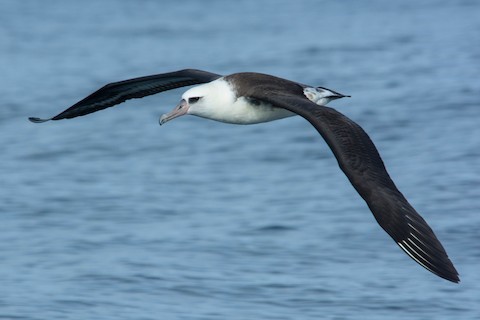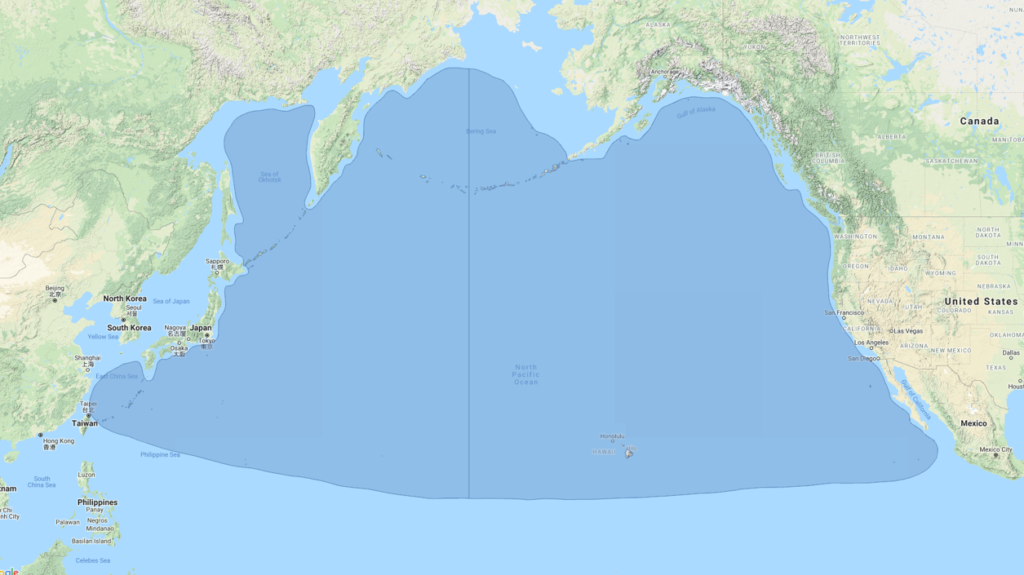Birdfinding.info ⇒ The common albatross of Hawaii and the Bering Sea. Uncommon but increasing in the eastern North Pacific waters directly accessible from continental American ports. A few are seen annually on pelagic trips out of ports from Alaska to Baja California—at any time of year, but mostly from July to October when the breeding population is at sea. It can also be found in Japanese waters east of Honshu and Hokkaido, and south to the Ogasawara Islands. In Hawaii it breeds abundantly in parts of the Northwest Chain and in growing numbers on Oahu and Kauai. On Oahu, over 100 pairs nest at Ka’ena Point and nesting began in 2017 at James Campbell National Wildlife Refuge. On Kauai, about 100 pairs nest at Kilauea Point and scattered pairs nest in open areas, including golf courses, along the northern coast from Princeville to Anahola.
Laysan Albatross
Phoebastria immutabilis
Breeds in Hawaii, and in much smaller numbers on offshore islands of Japan and Mexico. Disperses throughout the North Pacific and adjacent seas.
Breeding. Nests in November or December, mostly in large colonies on remote atolls but also in scattered pairs and small groups on headlands of larger islands. Most juveniles fledge in May and June.
Midway Atoll supports well over half of the global population, with about 600,000 nesting pairs—but varying widely: e.g., 284,600 in 2000-01 versus 666,044 in 2014-15. Other colonies in the Northwest Chain of Hawaii are on Laysan (~140,000), Lisianski (~26,500), Kure (~25,000), Pearl and Hermes Reefs (~7,000), French Frigate Shoals (~3,100), and Necker (~500).
In the main Hawaiian Islands, smaller numbers nest on Kauai (~300), Oahu (~150), Lehua (~90), Ka’ula (~65), and Ni’ihau (~25).

Laysan Albatrosses at their largest breeding colony. (Sand Island, Midway Atoll National Wildlife Refuge, Hawaii; April 9, 2018.) © Eric VanderWerf
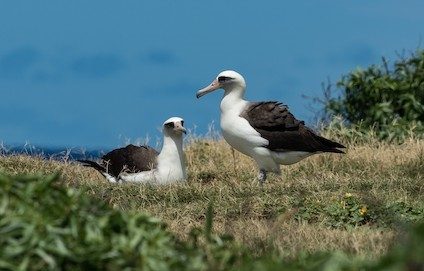
Laysan Albatrosses at a recently colonized nesting area. (Ka’ena Point, Oahu, Hawaii; March 26, 2018.) © Forest Jarvis
Also breeds in the western North Pacific on Wake Island, and in Japan’s Ogasawara Islands on on Mukojima (~20 pairs).
Began colonizing Mexican islands in the 1980s, where the population has increased steadily: Guadalupe (~500 pairs), Clarión (~100), and a few on Rocas Alijos and Isla San Benedicto.
Nonbreeding. Subadults and nonbreeding adults remain at sea year-round, dispersing essentially throughout the North Pacific, south to around 20° N and north into the Sea of Okhotsk and Bering Sea.
A large portion of the population summers in the Bering Sea and around the Aleutian Chain, especially during the nonbreeding months, from July to October. Southward, it seems to be present year-round in most of its at-sea range.
Identification
Usually the only albatross in the North Pacific that has the typical mollymawk pattern: a mostly whitish body and mostly dark wings and back.

Laysan Albatross. (Offshore from Bodega Bay, California; August 25, 2019.) © Darren Clark
The head is whitish except for a dark area around the eye—most of the dark feathering is forward of the eye, with a partial browstripe extending behind it and a grayish shadow extending down across the cheeks.
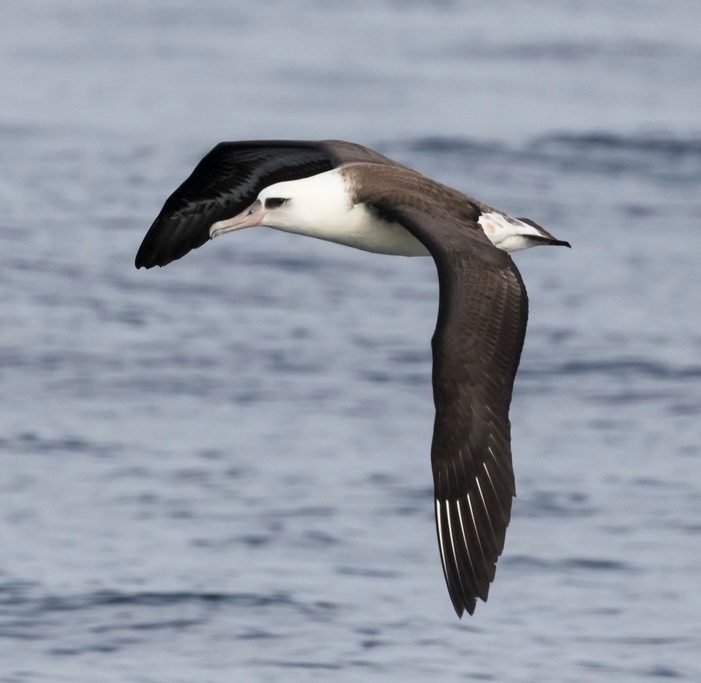
Laysan Albatross. (Offshore from Newport, Oregon; August 25, 2018.) © Ken Chamberlain
The bill is mostly pale—either plain, pinkish, yellowish, or orangish—and subtly shades to gray near the tip.
The uppersides of the wings are entirely dark-brown, except that the primaries have bright white shafts.
The back is also dark-brown down to the upper half of the rump—more extensive than on true mollymawks. The lower part of the rump is mostly white, often appearing as a U-shaped band.
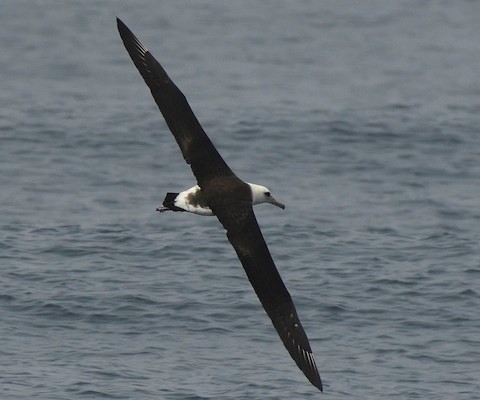
Laysan Albatross, showing characteristic U-shaped white rump band and feet projecting past short tail. (Offshore from Bodega Bay, California; August 25, 2019.) © Steve Butterworth
The tail is short and dark-brown. The feet are pinkish-gray and often visible in flight as they project past the end of the tail.
The undersides of the wings vary on a spectrum from mostly dark to mostly white. The most typical pattern consists of dark leading and trailing edges that frame a mostly white central area which is interrupted by sizeable dark patches on the primary coverts, inner secondary coverts, and axillaries.
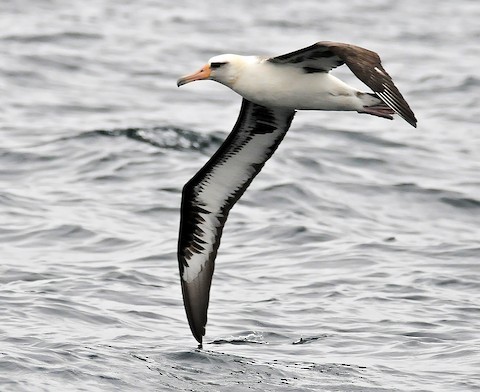
Laysan Albatross, showing typical underwing pattern. (Sitkin Sound, Alaska; May 26, 2008.) © Steven Mlodinow

Laysan Albatross with extensively white underwings. (Offshore from Fort Bragg, California; September 24, 2017.) © Robert Doster
At one end of the spectrum, some individuals have mostly white underwings, with narrow dark leading and trailing edges. At the other end of the spectrum, some individuals have almost entirely dark underwings with two uneven rows of white or partly white coverts.
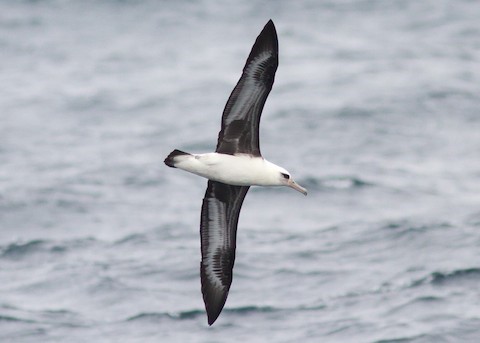
Laysan Albatross with darker-than-average underwings. (Bodega Canyon, California; August 20, 2017.) © Alan Wight
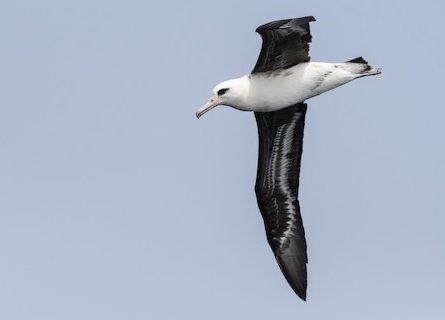
Laysan Albatross with extensively dark underwings. (Offshore from Bodega Bay, California; August 25, 2019.) © Darren Clark
For a brief time, juveniles retain some dark down on the head and neck. Otherwise age classes are generally indistinguishable.
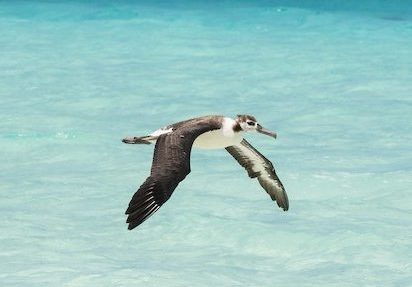
Laysan Albatross, recently fledged juvenile with dark downy feathers remaining on the head and neck. (Sand Island, Midway Atoll National Wildlife Refuge, Hawaii; August 22, 2017.) © Eric VanderWerf
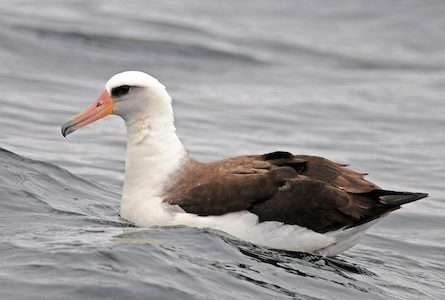
Laysan Albatross, one whose bill shows a notable orange flush and contrasting gray tip. (Sitkin Sound, Alaska; May 26, 2008.) © Steven Mlodinow
Notes
Monotypic species.
IUCN Red List Status: Near Threatened.
See below for a comparison of Laysan Albatross with the mollymawks: Black-browed, Campbell, and White-capped Albatrosses.
Cf. Black-browed, Campbell, and White-capped Albatrosses. Laysan is the only mollymawk-type albatross that normally occurs in the North Pacific. It has not been recorded in the Southern Hemisphere, where all of the true mollymawks (genus Thalassarche) usually remain, so the potential for overlap is limited to exceptional instances of long-distance vagrancy. The most similar mollymawks are Black-browed, Campbell, and White-capped (“Tasmanian Shy” and “Auckland Shy”) Albatrosses, all of which have mostly white heads except for dark feathering around the eye, as on Laysan.
The most consistent difference between Laysan and the similar mollymawks, visible even at long range, is the extent of white on rump: Laysan’s dark back typically extends to the middle of the rump, whereas the mollymawks all have completely white rumps. The extent of the dark portion of Laysan’s rump varies, so some borderline cases could occur and require consideration of other factors. The other differences are difficult to summarize because the mollymawks differ among themselves and by age, and Laysan has unusually variable underwing patterns.
Additional Photos of Laysan Albatross
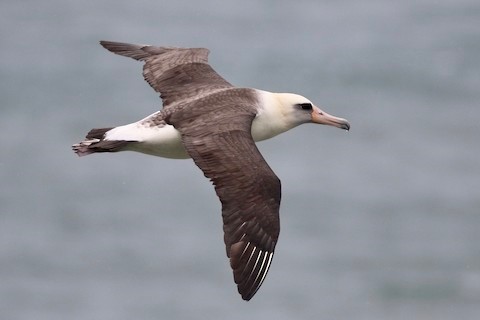
Laysan Albatross, with an atypically extensive white rump. (Kilauea Point National Wildlife Refuge, Kauai, Hawaii; March 22, 2018.) © Russ Morgan
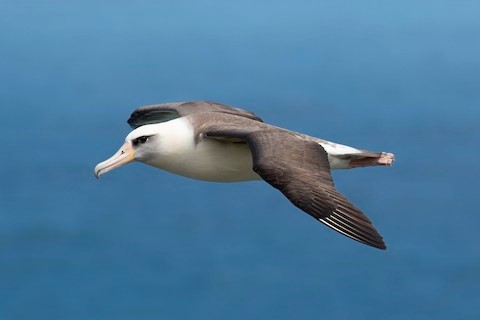
Laysan Albatross. (Kilauea Point National Wildlife Refuge, Kauai, Hawaii; March 10, 2020.) © Chris Burney

Laysan Albatross. (Kilauea Point National Wildlife Refuge, Kauai, Hawaii; February 19, 2019.) © Eric Hansen
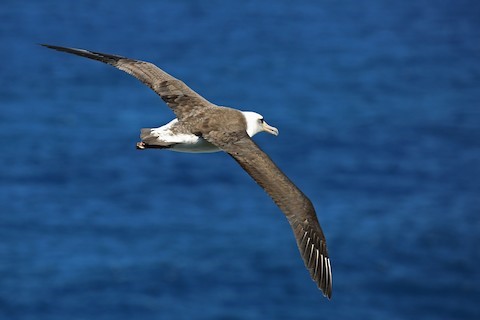
Laysan Albatross, showing U-shaped white rump band. (Kilauea Point National Wildlife Refuge, Kauai, Hawaii; December 15, 2016.) © Laura Keene
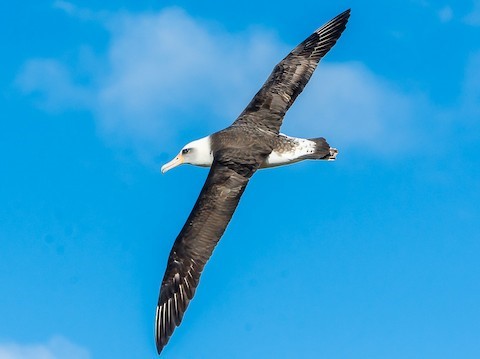
Laysan Albatross. (Ka’ena Point, Oahu, Hawaii; December 24, 2017.) © Jim Merritt

Laysan Albatross, showing U-shaped white rump band. (Offshore from Westport, Washington; August 25, 2013.) © Ed Harper

Laysan Albatross, showing typical underwing pattern. (Kaulakahi Channel, Hawaii; April 16, 2016.) © Jacob Drucker

Laysan Albatross, showing typical underwing pattern. (Ka’ena Point, Oahu, Hawaii; March 25, 2020.) © David Brock

Laysan Albatross, showing typical underwing pattern. (Kilauea Point National Wildlife Refuge, Kauai, Hawaii; March 22, 2018.) © Russ Morgan
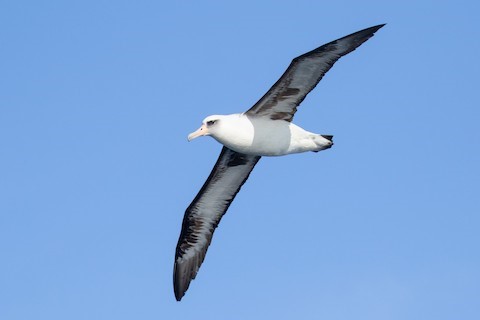
Laysan Albatross, showing typical underwing pattern. (Offshore from Tofino, British Columbia; March 17, 2019.) © Ilya Povalyaev

Laysan Albatross with darker-than-average underwings. (Offshore from Westport, Washington; February 14, 2015.) © Mike Charest
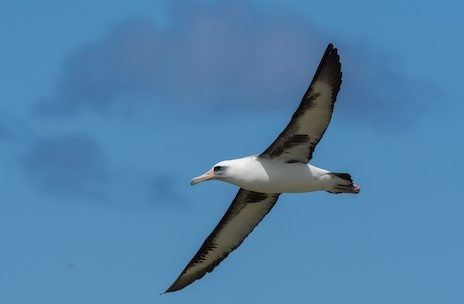
Laysan Albatross with extensively white underwings. (Ka’ena Point, Oahu, Hawaii; March 26, 2018.) © Forest Jarvis
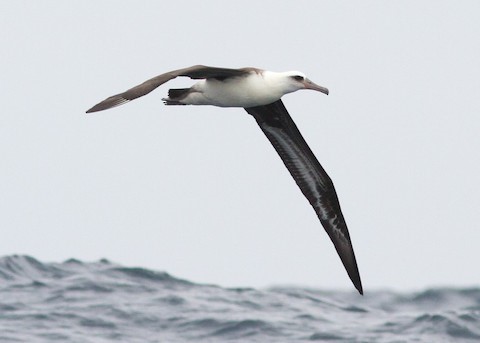
Laysan Albatross with darker-than-average underwings. (Bodega Canyon, California; August 20, 2017.) © Alan Wight

Laysan Albatross with extensively white underwings. (Offshore from Westport, Washington; September 21, 2019.) © Kari Freiboth
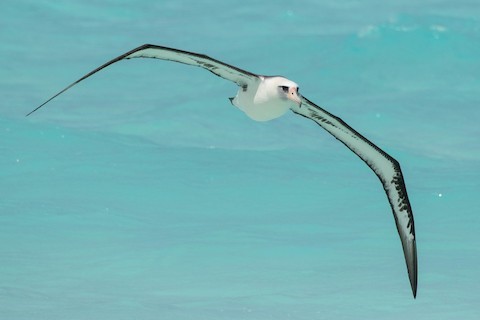
Laysan Albatross with whiteer-than-average underwings. (Sand Island, Midway Atoll National Wildlife Refuge, Hawaii; April 9, 2018.) © Eric VanderWerf
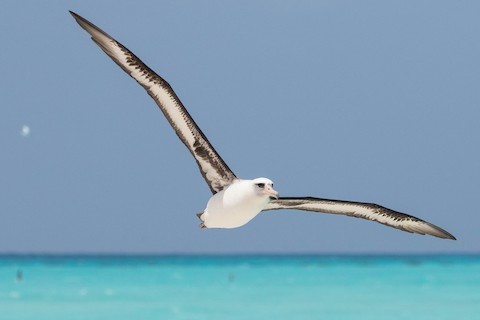
Laysan Albatross. (Sand Island, Midway Atoll National Wildlife Refuge, Hawaii; April 9, 2018.) © Eric VanderWerf
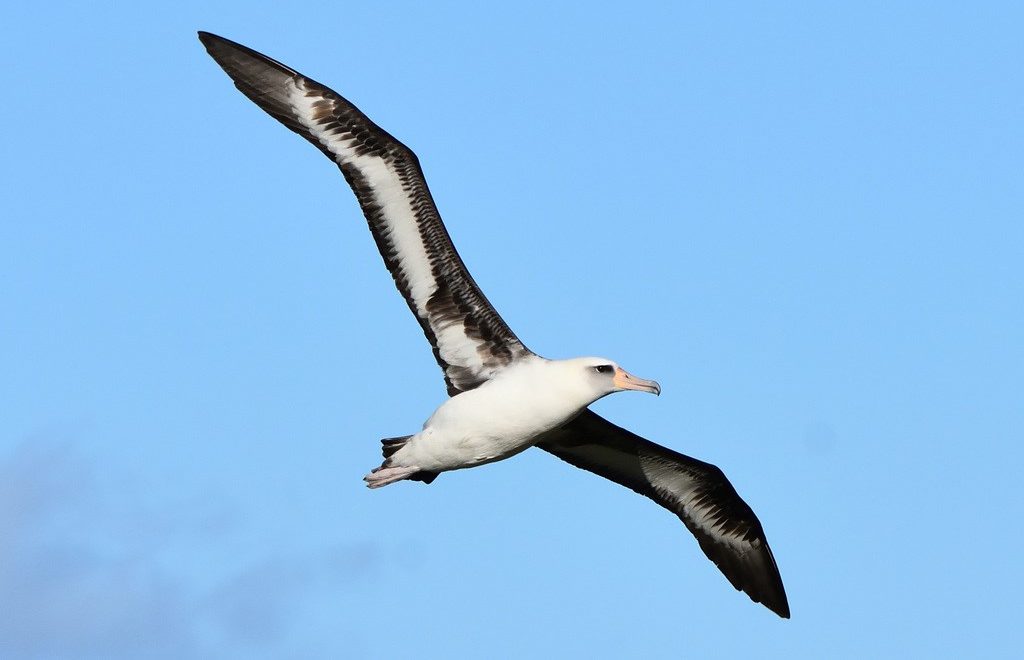
Laysan Albatross with darker-than-average underwings. (Turtle Bay Resort, Oahu, Hawaii; January 2, 2017.) © Doug Clarke

Laysan Albatross with extensively dark underwings. (Offshore from San Mateo County, California; August 24, 2019.) © Steve Kelling

Laysan Albatross. (Pioneer Canyon, California; July 21, 2013.) © Caroline Lambert
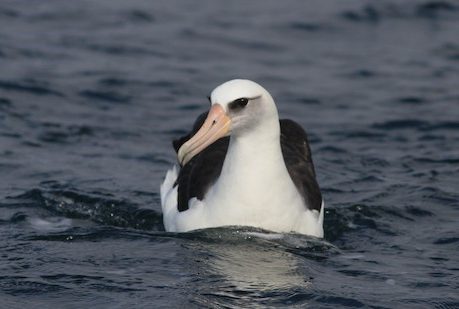
Laysan Albatross. (Offshore north of Unalaska Island, Alaska; June 21, 2017.) © Stephan Lorenz

Laysan Albatross. (Offshore from Newport, Oregon; April 18, 2009.) © Greg Gillson
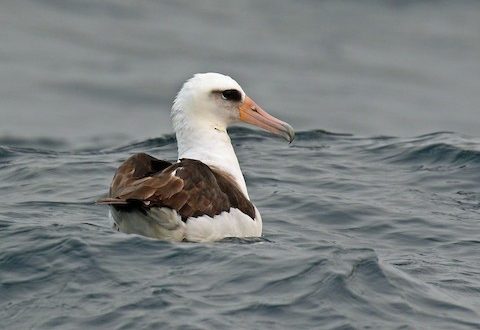
Laysan Albatross. (Offshore from Westport, Washington; August 12, 2018.) © Blair Bernson

Laysan Albatross, resting on a golf course where several pairs have nested. (Princeville, Kauai, Hawaii; February 27, 2020.) © Donna Pomeroy

Laysan Albatross, awkwardly modeling the identification band on one of its pinkish-gray feet. (Princeville, Kauai, Hawaii; February 27, 2020.) © Donna Pomeroy

Laysan Albatross, on nest. (Ka’ena Point, Oahu, Hawaii; March 6, 2020.) © Lucas Corneliussen
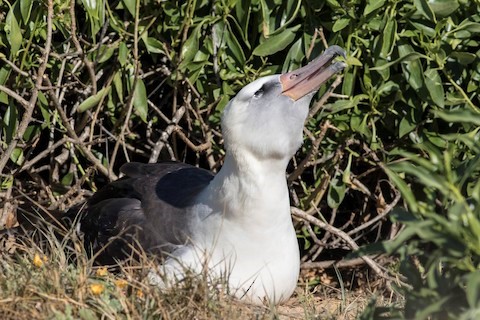
Laysan Albatross, braying. (Ka’ena Point, Oahu, Hawaii; January 20, 2019.) © Jacob Drucker
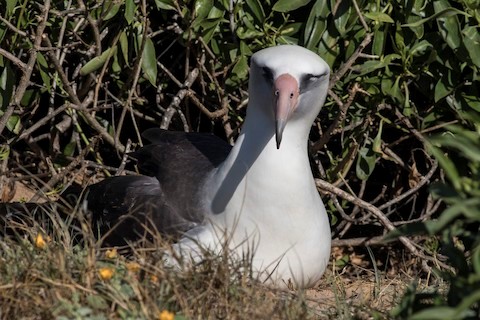
Laysan Albatross, frontal view showing head structure. (Ka’ena Point, Oahu, Hawaii; January 20, 2019.) © Jacob Drucker
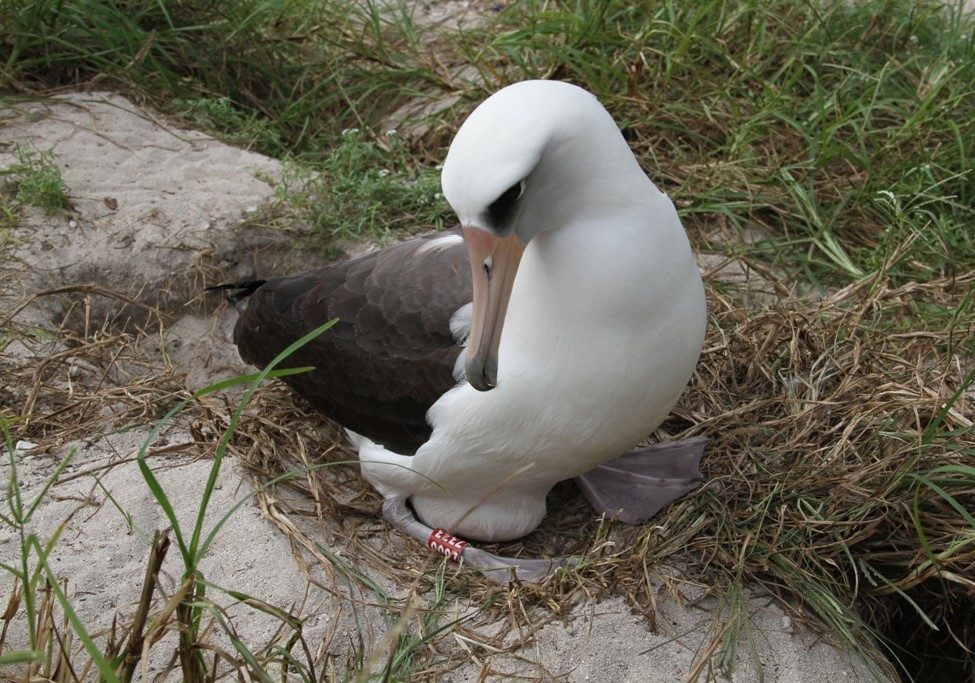
Laysan Albatross, named “Wisdom” was at least 60 years old in this photograph, having been banded when already a breeding adult in 1956. (Midway Atoll National Wildlife Refuge, Hawaii; December 1, 2011.) U.S. Fish & Wildlife Service

Laysan Albatross, showing gray facial shadow. (Ka’ena Point, Oahu, Hawaii; March 6, 2020.) © Lucas Corneliussen

Laysan Albatross, close view of gray shading on face. (Ka’ena Point, Oahu, Hawaii; January 20, 2019.) © Jacob Drucker

Laysan Albatross, juvenile. (Sand Island, Midway Atoll National Wildlife Refuge, Hawaii; August 22, 2017.) © Eric VanderWerf

Hybrid Laysan-x-Black-footed Albatross, among Laysans. (Sand Island, Midway Atoll National Wildlife Refuge, Hawaii; April 9, 2018.) © Eric VanderWerf

Laysan Albatross, juvenile. (Princeville, Kauai, Hawaii; June 27, 2012.) © Daniel Lebbin
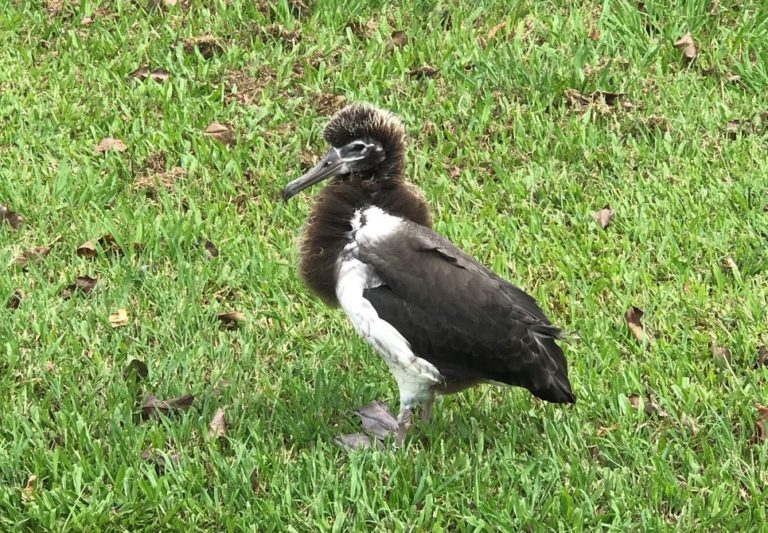
Laysan Albatross, fledgling. (Kauai, Hawaii; June 10, 2018.) © Bruce Smith

Laysan Albatross, juvenile. (Princeville, Kauai, Hawaii; June 27, 2012.) © Daniel Lebbin
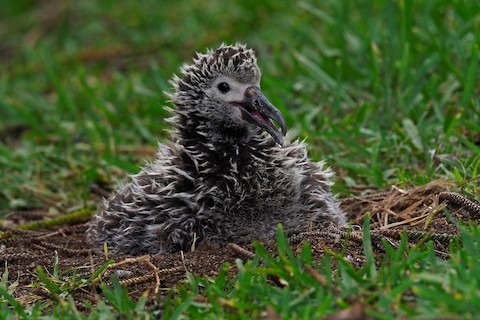
Laysan Albatross, nestling. (Princeville, Kauai, Hawaii; February 27, 2020.) © Donna Pomeroy
References
Alderfer, J., and J.L. Dunn. 2014. National Geographic Complete Birds of North America (Second Edition). National Geographic Society, Washington, D.C.
BirdLife International. 2018. Phoebastria immutabilis. The IUCN Red List of Threatened Species 2018: e.T22698365A132643073. https://dx.doi.org/10.2305/IUCN.UK.2018-2.RLTS.T22698365A132643073.en. (Accessed December 11, 2020.)
Brazil, M. 2009. Birds of East Asia. Princeton University Press.
Brooke, M. 2004. Albatrosses and Petrels across the World. Oxford University Press.
eBird. 2020. eBird: An online database of bird distribution and abundance. Cornell Lab of Ornithology, Ithaca, N.Y. http://www.ebird.org. (Accessed December 11, 2020.)
Harrison, P. 1983. Seabirds: An Identification Guide. Houghton Mifflin, Boston.
Howell, S.N.G. 2012. Petrels, Albatrosses & Storm-Petrels of North America. Princeton University Press.
Howell, S.N.G., and S. Webb. 1995. A Guide to the Birds of Mexico and Northern Central America. Oxford University Press.
Howell, S.N.G., and K. Zufelt. 2019. Oceanic Birds of the World. Princeton University Press.
Onley, D., and P. Scofield. 2007. Albatrosses, Petrels & Shearwaters of the World. Princeton University Press.
Pratt, H.D., P.L. Bruner, and D.G. Berrett. 1987. A Field Guide to the Birds of Hawaii and the Tropical Pacific. Princeton University Press.
Pyle, R.L., and P. Pyle. 2017. The Birds of the Hawaiian Islands: Occurrence, History, Distribution, and Status. Version 2 (January 1, 2017). http://hbs.bishopmuseum.org/birds/rlp-monograph/. B.P. Bishop Museum, Honolulu, Hawaii.
Raine, H., and A.F. Raine. 2020. ABA Field Guide to the Birds of Hawai’i. Scott & Nix, Inc., New York.
Seabirding of Japan. 2020. Laysan Albatross. http://seabirding-japan.com/laysan-albatross/. (Accessed December 12, 2020.)
Xeno-Canto. 2020. Laysan Albatross – Phoebastria immutabilis. https://www.xeno-canto.org/species/Phoebastria-immutabilis. (Accessed December 11, 2020.)
